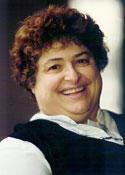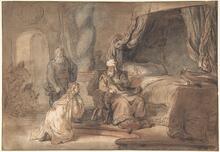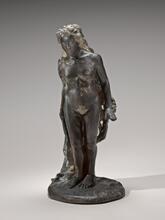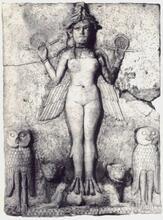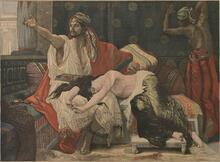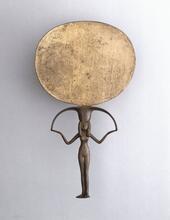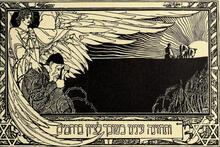Jewish Women in the New Testament
The New Testament tells us that Jewish women owned their own homes, had access to their own funds, appeared in synagogues and the Jerusalem Temple, participated in political activities, and served as patrons of the Jesus movement. These famous women include Mary the mother of Jesus (the Virgin Mary), Mary Magdalene, Junia the Apostle, Tabitha the disciple, and women in the Herodian family, including Herodias and her dancing daughter, Drucilla, and Berenice. The New Testament also mentions women from the Scriptures of Israel, including Sarah, Rebekah, Rachel, and Ruth. The article also traces Jesus’ comments on divorce, gender, and sexuality, anti-Jewish and historically inaccurate Christian readings that classify Jewish culture as highly misogynist and Jesus and Paul as early feminists, and rabbinic statements inappropriately applied to New Testament women.
While the New Testament provides substantial insight into the roles of Jewish women in Judea, Galilee, and the Diaspora in the late Second Temple period, much recent New Testament scholarship by Christians has ignored this wealth of information about women’s lives. Instead, a number of scholars have falsely claimed that late Second Temple Jewish social life epitomizes misogyny and that Jesus and Paul were intentionally involved in rescuing Jewish women from patriarchy and androcentrism. This article surveys the diverse New Testament depictions of Jewish women in Judea, Galilee, and the Diaspora and addresses several such misreadings of Jewish women’s history.
The Gospels: Jewish Women in Galilee and Judea
The New Testament Gospels mention numerous Jewish women. Jesus’s family includes his mother Mary and (at least two unnamed) sisters (Matthew 13:56; Mark 6:3, as well as Mary’s cousin Elizabeth (Luke 1), of priestly descent and married to a priest, who first struggled with infertility and then in her old age became the mother of John the Baptist. The Gospel of Luke (2: 36-38) mentions Anna, a widow and a prophet from the tribe of Asher, who encounters the infant Jesus in the Jerusalem Temple. Some women experience Jesus as a healer of disease and demon possession. They include Peter’s mother-in-law (Matthew 8:14-15; Mark 1:29-31; Luke 4:38-30), whom Jesus heals of a fever and who then “serves” Jesus (Greek: diakoneo, whence the term “deacon”); a woman suffering from a vaginal or uterine hemorrhage (Matthew 9:20-22; Mark 5:25-34; Luke 8:43-48), Mary Magdalene, from whom Jesus exorcises seven demons (Luke 8:2); a bent-over woman in a synagogue (Luke 13:11-17); a widow from the town of Nain whose son Jesus raises from the dead (Luke 7:11-15); the wife of Jairus, a “synagogue ruler” (Greek: archisynagogos), and her daughter whom Jesus also resuscitates (Mark 5:40-43; Luke 8:51-56).
Jesus’s followers include Mary and Martha (Luke 10:38-42; John 11-12), two sisters who offer Jesus hospitality in the home Martha owns, and Mary Magdalene; Joanna (the wife of Chuza the steward of Herod Antipas), and an otherwise unknown woman named Susanna, who “provided for him according to their means” [Luke 8:1-3]) and thus served as his patrons. The unnamed wife of Zebedee, mother of the apostles James and John, advocates for her sons’ advancement in the movement (Matthew 20:20-23), while an unnamed woman hails Jesus from the crowd, blessing the womb that bore him and the breasts that nursed him (Luke 11:27-28). An unnamed, silent woman anoints Jesus’s head (Matthew 26:6-13; Mark 14:3-9), and Jesus explains that she has anointed him for his burial); another unnamed woman anoints his feet in thanksgiving for being forgiven (Luke 7:36-50). In John’s version of the anointing story, Mary, the sister of Martha, anoints Jesus’s feet (John 12:1-8). As Jesus goes to his execution, he addresses the women who have come to mourn his death with the title “daughters of Jerusalem” (Luke 23:28). Jewish women, variously named in the Gospels but always including Mary Magdalene, witness Jesus’s crucifixion and burial, discover his tomb to be empty, and then experience Jesus as resurrected. It is possible that one of the two travelers who encounter the risen Jesus, incognito, on the road to Emmaus (Luke 26:13-33) was a woman (Greek masculine plural verbs mask women’s presence).
Other Jewish women mentioned in the Gospels include Galilean women who appear at the first mass feeding (Matthew 14:21 reads, “those who ate were about five thousand men, besides women and children”); a widow who donates her last two coins to the Temple treasury (Mark 12:41-44; Luke 21:1-4); the mother of a blind man whom Jesus heals (John 9:18-22); and a woman, caught in the act of adultery, about whom Jesus famously says, “Let the one among you who is without sin cast the first stone” (John 8:7). Jesus observes that prostitutes and tax collectors followed John the Baptist (Matthew 21:31-32); no New Testament text describes Mary Magdalene as a prostitute). In challenging Jesus about his teaching regarding resurrection (a view most Galilean and Judean Jews shared), the Sadducees, outliers who did not believe in resurrection, ask Jesus about a woman who had married seven brothers, one after another, according to levirate law: Whose wife is she in the resurrection? Jesus responds by reframing the question (Matthew 22:23-33; Mark 12:18-27; Luke 20:27-38).
Jesus also mentions women in his parables and sayings, including five wise and five foolish virgins who await a delayed bridegroom (Matthew 25:1-13) and a tenacious widow who frightens an unjust judge into granting her legal request (Luke 18:2-8). Typically, his sayings locate Jewish women in traditional gender roles. For example, “on that night there will be two men reclining on a dining couch; one will be taken and the other left; there will be two women grinding meal together; one will be taken and the other left (Luke 17:34-35, and see Matt 24:41, where the men are in the field). He matches a parable about a sheep owner who loses and then finds his sheep in a field with a parable about a woman who loses and then finds a coin in her home (Luke 15:4-10). The man celebrates his find with other men (and possibly women: the Greek is masculine plural). The woman celebrates her find with other women (the Greek is feminine plural). Other parables pair a man planting a mustard seed with a woman baking (Matthew 13:31-33; Luke 13:19-21). Jesus’s comments about children playing in the marketplace, although using the masculine plural, likely would have been understood as including girls (Matthew 11:16-17; Luke 7:32), and the professional mourners who gather at the home of Jairus and his wife would have included women (Matthew 9:23).
In the Book of Acts, written by the same author who composed the Gospel of Luke, Jewish women again feature in prominent roles. They are among Jesus’s followers who gather in Jerusalem following his death and who experience the descent of the Holy Spirit (Acts 1:14; 2:17). One of these followers, Sapphira the wife of Ananias, conspires with her husband to withhold money from the group; when Peter reveals that he knows their deceit, she and her husband both drop dead (Acts 5:1-11). Numerous widows, some Aramaic/Hebrew-speaking and others Greek-speaking, join the movement in Jerusalem (Acts 6:1). Before his experience on the road to Damascus, Paul persecuted Jewish members of the movement, including women (Acts 9:2), who were teaching gentiles about Jesus and probably telling them to stop worshiping the local gods. One of Paul’s followers, Timothy, the son of a gentile father and a Jewish woman named Eunice, appears in both Acts (16:1-13) and Paul’s epistles; 2 Timothy 1:5 identifies Timothy’s maternal grandmother as Lois.
Acts 12:12 reports that Mary, the mother of Paul’s one-time companion John Mark, owns a house in Jerusalem where Jesus’s followers gather. The first adherent to the movement in Europe, Lydia, a dealer in purple cloth, whom Paul encounters in Philippi, was likely Jewish (Acts 16:13-15). In Joppa, Peter raises from the dead a Jewish woman named both Tabitha (Aramaic) and Dorcas (Greek). Known for her charity, as well as for working in textiles, she served as a patron to a group of widows (Acts 9:36-42). Another follower, Priscilla (also called Prisca), the wife of Aquila, had been expelled with other Jews from Rome by Claudius in 49 C.E. (Acts 18:2, 18, 26); Paul mentions the couple in several of his letters (Romans 16:3; 1 Corinthians 16:19; 2 Timothy 4:19). Acts 21:9 locates in Caesarea Maritima the four virgin daughters of Philip, one of the early Greek-speaking Jews to join the movement, who had the gift of prophecy; Acts 23:16 mentions that Paul of Tarsus had a sister who aided him.
Not all of these stories are historical, and the Gospels frequently present the same scene with different details. Nevertheless, the stories provide information about women’s lives. Jewish women owned their own homes, were not restricted to “women’s quarters” but appear in public gatherings and had freedom of travel. They had access to their own funds, sought health care from physicians, participated in public rituals such as funerals, and worshiped in synagogues and in the Jerusalem Temple. They served as patrons, worked at baking and in the textile industry as well as in the sex industry, and purchased goods in the market. Jewish women chose to follow Jesus when their husbands did not. That women assumed such roles, variously, can be confirmed by data from external sources, including the writings of Josephus and Philo, archaeological and inscriptional evidence, the Dead Sea Scrolls, careful sifting of rabbinic sources, the Apocrypha and Pseudepigrapha, and Greek and Roman texts and artifacts.
The Gospels and Acts also mention Jewish women in the household of the ruling Herodian dynasty, and these women appear, as well, in the writings of the first century C.E. historian Josephus. The Gospels mention Herodias, sister of Agrippa I and wife of Herod Antipas; she is best known for encouraging her daughter (not named in the Gospels, but identified, perhaps incorrectly, as Salome), who had pleased Antipas by dancing at his birthday party, to ask for the head of John the Baptist on a platter (Matthew 14:6-12; Mark 6:17-29; cf. Luke 3:19). Acts mentions the two sisters of Agrippa I: Drucilla (Acts 24:24), the wife of the Roman governor of Judea Felix, and Berenice (Acts 25:13, 23, 30), who would have an affair with the Roman general and later emperor Titus.
From Paul’s letters, other (likely) Jewish women in the movement, along with Priscilla, include those to whom Paul sends greetings in Romans 16: Junia the apostle, another Mary, Persis, Tryphanea and Tryphosa, and Julia. Finally, the New Testament also mentions Jewish women from earlier Scripture: Matthew’s genealogy includes Rahab and Ruth, regarded by many Jews at the time as proselytes to Judaism, along with Tamar (Genesis 38) and “the wife of Uriah” (i.e., Bathsheba). Matthew quotes Jeremiah 31 on Rachel, who weeps for her children. Paul creates an allegory of Sarah and Hagar. Other references include Rebecca and the parents of Moses.
Marriage, Divorce, Celibacy, and Continence
Asked by Pharisees about whether divorce was permitted (reasons for divorce were debated in late Second Temple Judaism), Jesus acknowledges that Deuteronomy (24:1-4) grants men the right to divorce their wives, but only as a concession for the people’s “hardness of heart” (Mark 10:5). He then states that Genesis overrides Deuteronomy, for, “from the beginning of creation, ‘God made them male and female’. . . . ‘For this reason a man shall leave his father and mother and be joined to his wife, and the two shall become one flesh.’ . . . Therefore, what God has joined together, let no one separate” (Mark 10:6-9; cf. 1 Corinthians 7:10, where Paul includes this teaching for his gentile audience). Certain Dead Sea Scrolls similarly use Genesis 2 in limiting divorce. Matthew’s Gospel repeats this commandment but permits divorce in cases of porneia (a broader category than adultery and corresponding to the mention in Deuteronomy 24:1 of divorce in the cases where the husband found in his wife ervat davar, “something objectionable”). Whereas Mark’s formulation presumes that Jewish women could divorce their husbands, Matthew’s does not.
At the same time, Jesus praises his followers who have “Left house or wife or brothers or parents or children for the sake of the kingdom of God” (Luke 18:29), and both Matthew and Luke (10:34-37 cf. Luke 12:51-53; 14:26) depict him as alluding to Micah 7:5-6 in saying, “Do not think that I have come to bring peace to the earth; I have not come to bring peace, but a sword. For I have come to set a man against his father, and a daughter against her mother, and a daughter-in-law against her mother-in-law… Whoever loves father or mother more than me is not worthy of me; and whoever loves son or daughter more than me is not worthy of me.
Jesus likely believed that, with the kingdom of heaven (i.e., the world to come) about to begin, people would become “like angels in heaven” for “in the resurrection they neither marry nor are given in marriage” (Matthew 22:30 cf. Luke 20:35-36). In Luke 23:29, written sometime toward the end of the first century C.E., Jesus is portrayed as predicting the Jewish War against Rome, which occurred between 66 and 70 C.E., when he tells the “daughters of Jerusalem” that the days are surely coming when they will say, ‘Blessed are the barren, and the wombs that never bore, and the breasts that never nursed’.”
Jesus himself was likely single: he self-identifies and is identified by others with the metaphor of “bridegroom,” but he never acts as a husband. Rather, he pulls people away from marital and natal relationships by setting up a new family (what anthropologists call “fictive kinship units”) and by assigning them new roles. When told that his mother, brothers, and sisters are seeking him, he replies, “‘Who are my mother and my brothers?’ And looking at those who sat around him, he said, ‘Here are my mother and my brothers! Whoever does the will of God is my brother and sister and mother’” (Mark 3:33-35). With the exceptions of Mary and Joseph and Jairus and his wife, none of the other women who encounter Jesus is depicted with an accompanying husband. Thus, it is plausible that many of the Jewish women who joined Jesus were single, widowed, or already divorced; in his company, they found a new family.
The Jewish women who followed Jesus did not do so because they were oppressed by the Jewish tradition; they did so for the same reasons as Jewish men: because Jesus healed them or exorcised their demons or because they found his message of the inbreaking of the kingdom of heaven compelling. However, although Jesus had female followers, the movement, like the rest of first-century Judean and Galilean culture, was androcentric and patriarchal. Jesus summons no women to join him, whereas he does call his male disciples; he tells his male inner circle, but no women, that they will sit on thrones and judge the twelve tribes of Israel; he commissions no women directly to preach or to teach people outside the community; he brings no women to witness his transfiguration, to eat at the Last Supper, or to be with him as he is arrested. It is possible that he did commission women and that women were present on these various occasions, but the New Testament Gospels did not record the details.
Contemporary Claims of First-Century Jewish Misogyny
Jesus is not proactive when it comes to empowering women, but some Christian and Messianic Jewish interpreters have attempted to portray him as such terms, by classifying his Jewish culture as epitomizing misogynism. Claims of Jewish misogyny as opposed to Christian egalitarianism have been common since the early 1970s, when Christian women, seeking greater roles in their churches, Catholic, Protestant, and Orthodox, sought New Testament support. If Jesus could be shown to have put women into leadership positions, these scholars had a fine argument for advancing women’s roles in church and academy. By placing Jesus in a (falsely reconstructed) setting where men were forbidden to talk to women, where women were treated as possessions rather than as human beings, where women could be divorced for the most trifling of reasons, Jesus’s encounters with women make him look like a first-century feminist.
In some cases, such apologists take rabbinic comments on questions of divorce, women’s education, or women’s sexuality out of context, retroject them back into the Second Temple period, and then read Jesus as rejecting such negative Jewish views about women. For example, still frequently heard is the claim that Jewish men were tossing their wives out, forcing them either into starvation or prostitution, because “the rabbis” [quote, unquote] said that a man could divorce for any reason, such as his wife’s burning his dinner or because he found someone prettier (m. Gittin 9-10). Jesus is thus portrayed as offering women economic security.
However, Jesus is not engaging in social engineering to protect women’s rights: in Mark 10:12 he also forbids women from divorcing their husbands. Keeping a woman chained to a man who hates her does not help the woman. Moreover, Jewish women had marriage contracts (ketubot) to protect them financially in case of divorce, and it is likely that in the late Second Temple period the more conservative view limiting divorce to cases of adultery was the norm.
Another common mistake is the claim that because of laws concerning ritual impurity in relation to menstruation and childbirth, Jewish women were marginalized and ostracized, and that by healing a woman with uterine or vaginal bleeding, Jesus is abolishing these laws. The correct view is that while according to Jewish law people are frequently ritually impure (from menstruation, childbearing, ejaculation, burying corpses, etc.), that impurity is in most cases a temporary state; individuals could regain purity easily by immersion, especially given the numerous ritual baths (mikvaot) in Judea and Galilee. Jesus does not abolish purity laws; to the contrary, he restores both men and women to states of ritual purity.
Similarly, apologists sometimes attribute comments in the Pauline literature limiting women’s roles in the gentile assemblies Paul founded to his “rabbinic background.” These comments include his statement that, “As in all the churches of the saints, women should be silent in the churches. For they are not permitted to speak, but should be subordinate, as the law also says. If there is anything they desire to know, let them ask their husbands at home. For it is shameful for a woman to speak in church (1 Corinthians 14:33b-35). Paul’s welcoming of women leaders, on the other hand, is cited as a progress away from Judaism. Apologists commonly cite the she’lo asani prayer, in which Jewish men thank God each day for not having made them women, slaves, or boors (a variant reads “gentiles”), and then contrast it with Paul’s comment, “There is no longer Jew or Greek, there is no longer slave or free, there is no longer male and female; for all of you are one in Christ Jesus” (Galatians 3:28). Missing from such reconstructions is the well-attested evidence of Jewish women as synagogue leaders (archisynagoga) and patrons in Second Temple times. Missing, also, is careful use of rabbinic sources, which are generally prescriptive rather than descriptive. In addition, the she’lo asani prayer is attributed Lit. "teaching," "study," or "learning." A compilation of the commentary and discussions of the amora'im on the Mishnah. When not specified, "Talmud" refers to the Babylonian Talmud.Talmud to Rabbi Meir (j. Menachot 43b:17), who lived 100 years later than Jesus. In another rabbinic text, the (Aramaic) A work containing a collection of tanna'itic beraitot, organized into a series of tractates each of which parallels a tractate of the Mishnah.Tosefta (t. Berakhot 6.23), Rebbi Yehudah explains that men are “obligated in [many ritual] mitzvot” (commandments) while women are not. Finally, in terms of equality before the divine, the rabbinic sages explain, “Whether Jew or gentile, man or woman, male or female slave, the holy spirit rests on them in accordance with their deeds” (Tanna debe Eliyahu 10).
Rather than invent a misogynist Jewish setting against which Jesus and Paul invented feminism, readers would do better to use the New Testament as one primary source, among many, for reconstructing the social and gender roles of women in the first century in Judea, the Galilee, and the Diaspora.
Brooten, Bernadette. Women Leaders in the Ancient Synagogue. Chico, CA: Scholars Press, 1982.
Ehrensperger, Kathy and Shayna Sheinfield, eds. Gender and Second Temple Judaism. Lanham, MD: Fortress Academic, 2020.
Ilan, Tal. “Gender.” In The Jewish Annotated New Testament, 2nd edition, edited by Amy-Jill Levine and Marc Z. Brettler, 611-614. New York: Oxford University Press, 2017.
Ilan, Tal. Integrating Women into Second Temple History. Tübingen: J.C.B. Mohr (Paul Siebeck), 1999.
Ilan, Tal. Jewish Women in Greco-Roman Palestine. Peabody, MA: Hendrikson, 1996.
Klawans, Jonathan. “Law.” In The Jewish Annotated New Testament. 2nd edition, edited by Amy-Jill Levine and Marc Z. Brettler, 655-657. New York: Oxford University Press, 2017
Kraemer, Ross Shepard. “Jewish Family Life.” In The Jewish Annotated New Testament. 2nd edition, edited by Amy-Jill Levine and Marc Z. Brettler, 537-539. New York: Oxford University Press, 2017.
Kraemer, Ross Shepard and Mary Rose D’Angelo, eds. Women and Christian Origins. New York: Oxford University Press, 1999.
Levine, Amy-Jill. The Misunderstood Jew: The Church and the Scandal of the Jewish Jesus. San Francisco: HarperSanFrancisco, 2006.
Levine, Amy-Jill. “The Word Becomes Flesh: Jesus, Gender, and Sexuality.” In Jesus Two Thousand Years Later, edited by J. H. Charlesworth and W. P. Weaver, 62-83. Faith and Scholarship Colloquies. Harrisburg, PA: Trinity Press International, 2000. Reprinted in The Historical Jesus in Recent Research, edited by J. D. G. Dunn and S. McKnight. Sources for Biblical and Theological Study 10. Winona Lake, IN: Eisenbrauns, 2005.
Levine, Amy-Jill et al. “The Disease of Post-Colonial New Testament Studies and the Hermeneutics of Healing.” Roundtable and Response. Journal of Feminist Studies in Religion 20, no. 1 (Spring, 2004): 91-132, 149-151.
Meyers, Carol et al., eds. Women in Scripture: A Dictionary of Named and Unnamed Women in the Hebrew Bible, The Apocryphal/Deuterocanonical Books, and the New Testament. Boston: Houghton Mifflin, 2000.
Satlow, Michael. “Marriage and Divorce.” In The Jewish Annotated New Testament, 2nd edition, edited by Amy-Jill Levine and Marc Z. Brettler, 608-611. New York: Oxford University Press, 2017.

